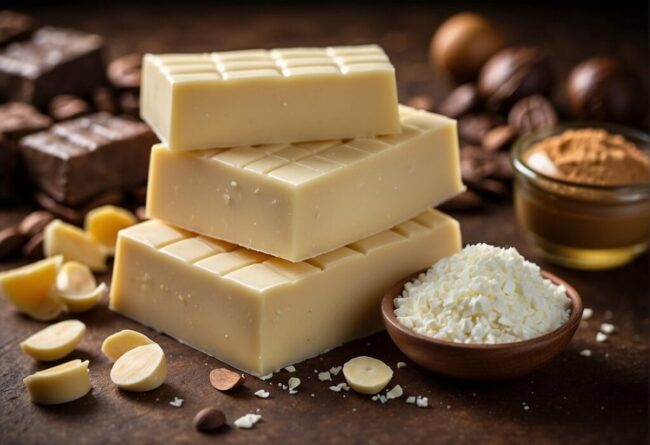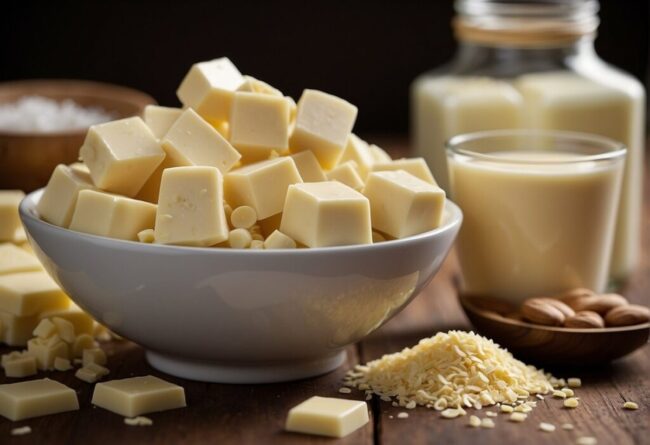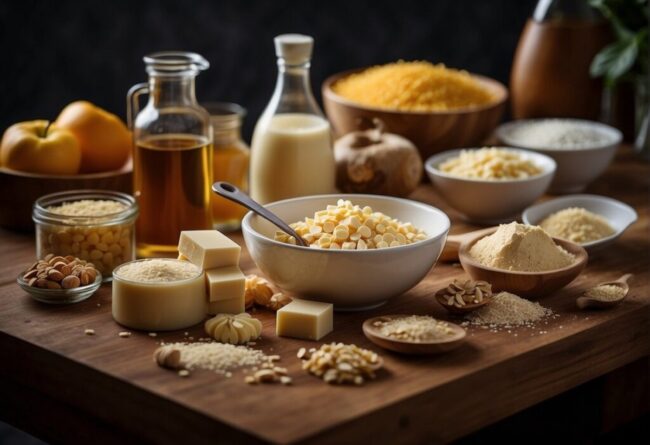4 Simple Swaps for White Chocolate in Recipes
White chocolate substitutes bring a way to maintain creamy sweetness in desserts without the original ingredient.
Different alternatives can provide smooth textures or a delicate hint of flavor.
Baking, melting, or topping treats still feels effortless with the right swap.
Every bite stays rich, satisfying, and just as enjoyable
What to Know About White Chocolate
White chocolate is a sweet, creamy confection made from cocoa butter, sugar, and milk solids. It is commonly used in baking, desserts, and confections.
White Chocolate Ingredients
White chocolate offers a creamy sweetness that many find irresistible.
The absence of cocoa solids gives it a unique flavor profile compared to its darker counterparts.
With at least 20% cocoa butter, this treat boasts an exceptional melt-in-your-mouth texture.
A blend of milk products adds richness, while sugar ensures each bite is sweet and satisfying.
Understanding its composition allows you to appreciate the delicate balance that makes white chocolate so enjoyable in desserts or on its own.
White Chocolate Features
White chocolate captivates with its rich, creamy texture derived from cocoa butter and milk.
The melting point is lower than that of dark or milk varieties, creating a delightful sensation as it dissolves on the palate.
Sweetness shines through in desserts, offering an appealing contrast to more bitter flavors.
This chocolate finds its place in various baked goods and confections, enhancing treats like cheesecakes or cookies with a luscious touch.
Experimenting with white chocolate can elevate your culinary creations to new heights; what will you whip up next?
Types of Chocolate Explained
White chocolate stands alone in the chocolate family due to its lack of cocoa solids.
This unique attribute sets it apart from both milk and dark chocolates, which contain varying percentages of cocoa that influence their flavor and texture.
The creamy combination of cocoa butter, milk solids or cream, and sugar creates a smooth sweetness that is distinctively different from the richer profiles found in dark or milk varieties.
A deeper understanding reveals how white chocolate occupies a special niche in desserts and confections, offering versatility for culinary creations.
With this knowledge at your fingertips, you can confidently explore new recipes or indulge your sweet tooth with something different on your next dessert adventure.
White Chocolate Replacement Options
White chocolate substitutes offer creamy and sweet alternatives for baking and desserts. They maintain the richness while adding a unique twist.
Dairy-Based Alternatives
Milk chocolate serves as a wonderful alternative to white chocolate, adding a deeper hue and maintaining sweetness.
This option melts beautifully, ensuring your dessert retains that desirable creamy texture.
Butterscotch chips introduce an exciting twist with their distinct flavor, elevating any treat they touch.
The combination of these two ingredients can create delightful contrasts in both taste and appearance.
Consider experimenting with these substitutes to discover new favorites in your baking adventures!
Vegan and Dairy-Free Options
Coconut milk offers a delightful creaminess and mild sweetness that enhances many dishes.
Its versatility allows for use in both savory and sweet recipes, making it a staple in various cuisines.
Almond milk serves as another excellent choice, particularly when infused with vanilla to elevate its taste profile.
Vegan white chocolate presents an exciting alternative for those avoiding dairy, combining sugar with cocoa butter and plant-based milks like rice milk powder for rich flavors.
Specialty stores often carry these unique ingredients, expanding options for creative cooking adventures without compromising dietary preferences.
Sweetness and Flavor Swaps
Vanilla extract adds a delightful sweetness that balances chocolate substitutes beautifully.
The rich flavor transforms ordinary desserts into something special, enhancing every bite.
Candy coating or almond bark provides a sweet alternative to traditional chocolate, making it an excellent choice for those seeking variety.
With its sugar content and creamy texture, this option mimics the taste of white chocolate perfectly.
Perfect for dipping fruits or drizzling over treats, these ingredients elevate your creations with minimal effort.
Texture-Based Alternatives
Finding the right substitute for white chocolate can be a game-changer in your recipes.
A creamy texture plays a crucial role, and using cream or blending milk powder with butter can replicate that richness perfectly.
Achieving the ideal melting point ensures that your dishes maintain their intended consistency, so testing small amounts before diving into full batches is wise.
This attention to detail guarantees smooth results without any surprises during cooking or baking.
Experimenting with these substitutes opens up new avenues for creativity in the kitchen while satisfying those cravings for something sweet and luscious.
Using White Chocolate in Recipes
Using white chocolate in recipes enhances creaminess and adds a mild sweetness. It pairs well with fruit, nuts, and spices for balanced flavors.
Baking with Alternatives
Choosing the right substitute can elevate your baking experience.
Vanilla almond bark or candy coating easily mimic white chocolate's sweetness and texture, seamlessly fitting into cookies or brownies.
For those with dietary needs, alternatives such as coconut milk provide a creamy consistency without dairy.
Cocoa butter combined with sugar serves as a delectable option for vegans, offering rich flavor without compromising on taste.
Adapting recipes becomes an exciting journey when you explore these flavorful choices!
Changing Flavor and Looks
White chocolate offers a smooth texture and a subtly sweet flavor that elevates baked treats.
A splash of vanilla extract can brighten the taste, especially if alternatives lack depth.
When choosing substitutes, pay attention to how they affect the final appearance; color and shine play significant roles in visual appeal.
Adjusting quantities or types of replacements may be necessary to match your expectations.
Each detail matters when striving for that perfect blend in your creations, so don’t hesitate to experiment until you find what works best for you.
Replacement Measurements and Ratios
Baking requires accuracy, and knowing how to substitute ingredients can make all the difference.
A handy reference chart provides quick solutions for common swaps, helping you avoid any baking mishaps.
Using a kitchen scale offers an extra layer of precision when measuring ingredients like chocolate chips or bars.
This tool simplifies conversions between different forms, ensuring your recipes turn out just right every time.
Keep this guide close for successful baking adventures that yield delicious results without stress!
Key Tips for Substitutes
Substituting ingredients can lead to unexpected results in your baking adventures.
Butterscotch chips introduce a rich flavor, yet their sweetness and melting properties differ from traditional chocolate.
Coconut milk presents its own challenges; adjusting the moisture level is crucial for achieving that perfect brownie or muffin consistency.
Testing with a small batch helps prevent disappointment when trying out new ingredients.
Each substitution holds potential, so exploring these options opens up exciting new flavors while keeping your baked goods delightful and satisfying.



